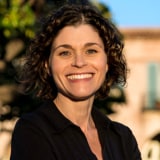 Early in my emergency medicine career, I was seated in the department with a colleague when I inquired about one of our co-workers I hadn’t seen in a while. “She’s on the Mommy Track,” my colleague said disdainfully. To me, selecting a career path that sacrificed traditional professional advancement for more time to raise children was legitimate. My colleague’s pejorative “Mommy Track” made it clear that to him, it was not.
Early in my emergency medicine career, I was seated in the department with a colleague when I inquired about one of our co-workers I hadn’t seen in a while. “She’s on the Mommy Track,” my colleague said disdainfully. To me, selecting a career path that sacrificed traditional professional advancement for more time to raise children was legitimate. My colleague’s pejorative “Mommy Track” made it clear that to him, it was not.
At that moment, I resolved to pursue a non-clinical supplement to my emergency department work, colloquially known as an “exit strategy.” Here, I’d like to offer my path for the benefit of other physicians – whether burned out, seeking more family time, or looking for creative outlets — as an example of what is possible outside of clinical medicine.
Emergency medicine is a fantastic field: daily work includes critical thinking, procedures, and the ability to make a positive impact when a patient is most vulnerable. But the field also has one of the highest burnout rates, likely secondary to erratic hours that can both interrupt family time and adversely affect health. It also suffers from a lack of autonomy: Usually, an emergency physician doesn’t get to pick her schedule, whom she works with, how heavy her workload is, or how burdensome the emotional toll of her workday might be.
Those inconsistent hours and lack of autonomy became relevant when I married another emergency physician and had two children. Raising toddlers plus the scheduling conflicts caused by two working emergency physicians rendered clinical hours less attractive. Doctors in other specialties may recognize this situation: many otherwise great medical fields have onerous disadvantages that also limit flexibility, autonomy, creativity, and family time.
I hadn’t possessed this lifestyle insight as a medical student. But, back then, I did know that medical school was making me feel unidimensional, so I availed myself of Harvard’s “five-year plan,” allowing me to graduate one year later with a nominal tuition difference. I spent time backpacking internationally, and—fortunately—discovered the American Association for the Advancement of Science Mass Media Science and Engineering Fellowship. Through this program, while working at Portland’s Oregonian newspaper, I learned the fundamentals of scientific writing for the lay press. I loved journalism but opted to complete my clinical training and matriculated into my residency program the next year.
After completing training, I was asked to stay on as faculty and was later selected as the Harvard Affiliated Emergency Medicine Program’s Assistant Residency Director. My favorite part of being on faculty was the residents. I liked supporting them and, simultaneously, in my assistant residency director role, I learned invaluable information about the residency admissions process, reviewing Electronic Residency Application Service (ERAS) documents, interviewing candidates, and selecting future classes of incoming trainees.
When I met my husband, we happily relocated to California. As I mentioned previously, we realized quickly that we were not achieving our shared vision of prioritizing family life. My husband’s practice did not allow part-timers, so I cut down my clinical hours and started to consider what I wanted and what my skillset was:
- I missed mentoring residents and medical students.
- I also really loved the work I had done as a journalist and missed focusing on words and their impact.
- I had a lot of experience interviewing applicants and understood what went on behind the closed doors of the residency application process.
- I wanted to work virtually, so I had the flexibility to spend maximum time with my husband and family.
Consequently, over 12 years ago, I founded Insider Medical Admissions, a consulting company that helps pre-meds and medical students improve their candidacies for medical school and residency, respectively. Throughout Insider’s growth, I have continued to work clinically part-time, a strategy I would recommend to any physician considering a non-clinical track until she is certain she will never see another patient. Years ago, I was given good advice to “keep an oar in the water” of clinical practice, and I would offer that recommendation to others seeking an exit strategy.
While Insider works very well for me, it has required thousands of hours of my time. My husband jokingly refers to my company as our third child. So, before committing yourself to an alternate to traditional medical practice, it’s critical to remember that non-clinical pathways offer imperfect solutions. Also, while clinical work can be exhausting and lack flexibility, it is usually geographically and financially secure in ways a non-clinical exit strategy may not be, especially at first.
By creating a clinical alternative tailored to my situation, I enjoy many of the aspects that replenished me as a Harvard Assistant Residency Director without the drawbacks or politics of an academic career. Thinking outside the box as an entrepreneur allowed me to renegotiate the impositions I accepted from clinical work. It’s liberating when you no longer face the constraints that entrap many colleagues in clinical medicine. It’s also empowering to find that, thanks to a supplemental income stream, you can reduce or eliminate the more depleting aspects of your job like nights and weekends.
My advice for the physician seeking options outside of clinical medicine is to create a list of your skills and decide which ones confer an "unfair" advantage that you might use to create an opportunity to generate a supplemental revenue stream. If you can’t identify your niche skill, invest in developing additional talents and expand your network: volunteer on hospital committees that allow you to become a known quantity to administration. Alternately, developing research or financial skills may allow you to branch out into pharmaceutical work or venture capital.
A golden parachute is woven over years, slowly and deliberately, one stitch at a time. Create yours now, and you gift yourself a graceful glide path out of medicine from the comfortable height of your career. Ignore your golden parachute, and you risk an ill-conceived exit from a career that no longer keeps you aloft.
Illustration by April Brust





